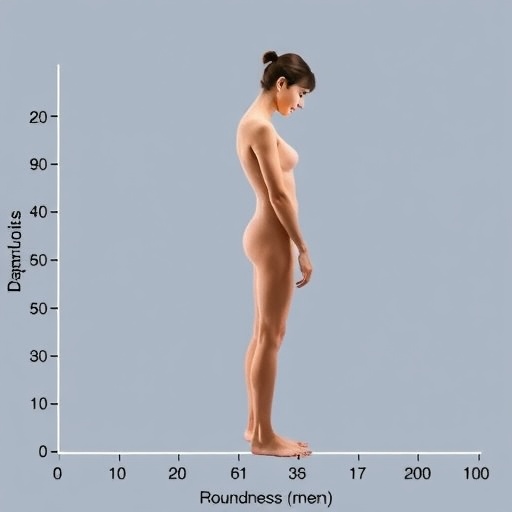In a groundbreaking nationwide cohort study spearheaded by researchers Zhao, Long, and Wang, recent findings have unveiled a compelling link between the Body Roundness Index (BRI) and the progression of depressive symptoms among middle-aged and older Chinese adults. This comprehensive investigation, published in BMC Psychology in 2025, delves into the nuanced relationship between physical health metrics and mental health trajectories, leveraging data from the China Health and Retirement Longitudinal Study (CHARLS).
The Body Roundness Index, a novel anthropometric metric devised to assess body shape and fat distribution, transcends traditional measures like Body Mass Index (BMI) by incorporating waist circumference and height parameters to provide a more accurate reflection of visceral adiposity. The researchers posited that BRI, given its enhanced predictive capacity for cardiometabolic risks, might also serve as a biomarker for psychological distress, particularly depressive symptomatology, which remains a pervasive yet often underrecognized health burden in aging populations.
Utilizing longitudinal data spanning multiple waves from CHARLS, the study meticulously tracked depressive symptoms employing standardized scales such as the Center for Epidemiologic Studies Depression Scale (CES-D). The extensive sample cohort included thousands of participants aged 45 and above, offering a rich demographic spectrum that encapsulates diverse socioeconomic backgrounds and regional disparities across China. This comprehensive dataset facilitated a robust temporal analysis of depressive symptom trajectories vis-à-vis BRI measurements.
One of the pivotal revelations from the study is the identification of distinct depressive symptom trajectories associated with varying BRI levels. Participants exhibiting elevated BRI were found to have a higher likelihood of persistent or worsening depressive symptoms over time, suggesting that body roundness may act as a significant predictor in the chronicity and intensification of depression among older adults. This finding underscores the intricate bi-directional interplay between physical and mental health domains.
The pathophysiological underpinnings of this association are multifaceted. Visceral adiposity, as captured by BRI, is known to contribute to systemic inflammation, dysregulated hypothalamic-pituitary-adrenal (HPA) axis activity, and insulin resistance—all of which have been implicated in the etiology of depressive disorders. Moreover, increased body roundness often correlates with diminished physical mobility and social isolation, compounding psychological vulnerability.
This study also contributes to the growing discourse on personalized medicine and preventative psychiatry by suggesting that anthropometric assessments like BRI could be integrated into routine screening processes for mental health risk stratification, particularly in resource-constrained settings. Early identification of individuals at risk for depression through non-invasive, easily obtainable physical health indices could potentially catalyze timely interventions.
Furthermore, the researchers highlight the sociocultural context of aging in China, where shifts towards Westernized lifestyles and urbanization have exacerbated metabolic health challenges. The increased prevalence of obesity and sedentary behavior, coupled with rapidly changing family structures and social support networks, may potentiate the observed associations between BRI and depressive symptom trajectories.
Importantly, the study employed advanced statistical modeling techniques, including latent class growth analysis, to categorize depressive symptom patterns over time, allowing for nuanced differentiation between transient, remitting, and persistent symptom profiles. This methodological rigor enhances the validity of the observed correlations and supports the dynamic conceptualization of depression as a heterogeneous and temporally variable condition.
The implications of these findings extend beyond epidemiological insights, advocating for integrated healthcare models that address both metabolic and mental health burdens concurrently. Public health policies that promote physical activity, nutritional education, and weight management could have collateral benefits in mitigating depression risk, particularly among middle-aged and elderly demographics.
Moreover, the study’s emphasis on the use of BRI as a more precise indicator than traditional BMI invites further exploration into the role of fat distribution rather than overall adiposity in mental health outcomes. This distinction could recalibrate clinical risk assessments and inform targeted therapeutic strategies that address specific metabolic phenotypes.
From a neuroscience perspective, the link between increased visceral fat and disrupted monoaminergic neurotransmission may provide a biological rationale for the observed depressive symptom trajectories. Chronic low-grade inflammation associated with adipose tissue can influence neuroinflammatory pathways, altering brain regions implicated in mood regulation such as the prefrontal cortex and hippocampus.
Ethnic and genetic factors unique to the Chinese population were also taken into account, acknowledging that variations in genetic polymorphisms related to fat metabolism and inflammatory responses might modulate susceptibility to depression, thereby enriching the contextual relevance of the findings.
In summary, this pioneering research firmly establishes the Body Roundness Index as not merely a marker of physical health, but as a potent predictor of mental health trajectories in aging populations. Its integration into routine health assessments could revolutionize the preventive framework for depression, underscoring the inseparable nexus between body and mind.
As mental health awareness gains momentum worldwide, especially in the context of an aging global demographic, studies like this exemplify the interdisciplinary approach necessary to unravel the complex biopsychosocial factors driving depression. The innovative use of BRI, combined with longitudinal data analytics, positions this research at the vanguard of psychiatric epidemiology and public health.
Future research directions include experimental interventions targeting visceral adiposity reduction and their subsequent effects on depressive symptom amelioration. Moreover, expanding similar analyses to different ethnic cohorts could validate the universality or specificity of the association between body roundness and depression.
By bridging the gap between somatic and psychological health through sophisticated measurement tools and longitudinal inquiry, this study paves the way for more holistic, predictive, and personalized health care paradigms that could substantially alleviate the global depression burden.
Subject of Research: The association between Body Roundness Index (BRI) and trajectories of depressive symptoms among middle-aged and older Chinese adults, analyzed through longitudinal data from the China Health and Retirement Longitudinal Study (CHARLS).
Article Title: Association between body roundness index and trajectories of depressive symptoms among Chinese middle-aged and older adults: a nationwide cohort study from CHARLS.
Article References:
Zhao, D., Long, X. & Wang, J. Association between body roundness index and trajectories of depressive symptoms among Chinese middle-aged and older adults: a nationwide cohort study from CHARLS. BMC Psychol 13, 1274 (2025). https://doi.org/10.1186/s40359-025-03621-z
Image Credits: AI Generated




